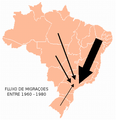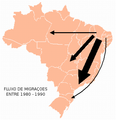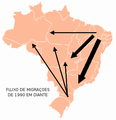
Brazil is geopolitically divided into five regions, by the Brazilian Institute of Geography and Statistics, which are formed by the federative units of Brazil. Although officially recognized, the division is merely academic, considering geographic, social and economic factors, among others, and has no political effects other than orientating Federal-level government programs. Under the state level, they are further divided into intermediate regions and even further into immediate regions.

The Brazil socio-geographic division is a slightly different division than the Brazilian Division by Regions. It separates the country into three different and distinctive regions:
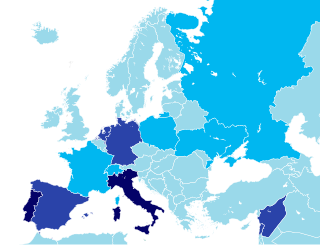
Immigration to Brazil is the movement to Brazil of foreign peoples to reside permanently. It should not be confused with the forcible bringing of people from Africa as slaves. Latin Europe accounted for four-fifths of the arrivals. This engendered a strikingly multicultural society. Yet over a few generations, Brazil absorbed these new populations in a manner that resembles the experience of the rest of the New World.
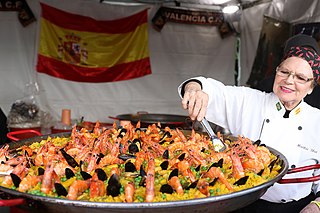
Spanish Brazilians are Brazilians of full or partial Spanish ancestry.

São Cristóvão is a traditional neighborhood in the north of Rio de Janeiro, Brazil.

Brazil is divided into several types and levels of subdivisions.

Brazilian industry has its earliest origin in workshops dating from the beginning of the 19th century. Most of the country's industrial establishments appeared in the Brazilian southeast, and, according to the Commerce, Agriculture, Factories and Navigation Joint, 77 establishments registered between 1808 and 1840 were classified as "factories" or "manufacturers". However, most, about 56 establishments, would be considered workshops by today's standards, directed toward the production of soap and tallow candles, snuff, spinning and weaving, foods, melting of iron and metals, wool and silk, amongst others. They used both slaves and free laborers.
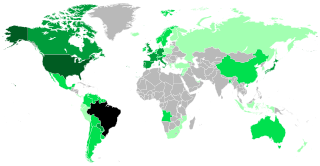
Brazilians are the citizens of Brazil. A Brazilian can also be a person born abroad to a Brazilian parent or legal guardian as well as a person who acquired Brazilian citizenship. Brazil is a multiethnic society, which means that it is home to people of many ethnic origins, and there is no correlation between one's stock and their Brazilian identity.
Internal migration or domestic migration is human migration within a country. Internal migration tends to be travel for education and for economic improvement or because of a natural disaster or civil disturbance, though a study based on the full formal economy of the United States found that the median post-move rise in income was only 1%.

Brazilian society is made up of a confluence of people of Indigenous, Portuguese, and African descent. Other major significant groups include Italians, Spaniards, Germans, Lebanese, and Japanese.

Russian Brazilians are Brazilian citizens of full or partial Russian ethnic background or Russian-born people residing in Brazil. The term can also refer to someone with a Brazilian mother and Russian father, or vice versa.

Brazil had an official resident population of 203 million in 2022, according to IBGE. Brazil is the seventh most populous country in the world, and the second most populous in the Americas and Western Hemisphere.
European immigration to Brazil refers to the movement of European people to Brazil. It should not be confused with the colonisation of the country by the Portuguese.
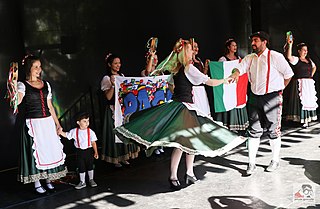
Italian Brazilians are Brazilians of full or partial Italian descent, whose ancestors were Italians who emigrated to Brazil during the Italian diaspora, or more recent Italian-born people who've settled in Brazil. Italian Brazilians are the largest number of people with full or partial Italian ancestry outside Italy, with São Paulo being the most populous city with Italian ancestry in the world. Nowadays, it is possible to find millions of descendants of Italians, from the southeastern state of Minas Gerais to the southernmost state of Rio Grande do Sul, with the majority living in São Paulo state. Small southern Brazilian towns, such as Nova Veneza, have as much as 95% of their population of Italian descent.
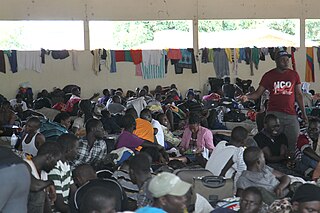
A Haitian Brazilian is a Brazilian person of full, partial, or predominantly Haitian ancestry, or a Haitian-born person residing in Brazil.
Brasil Central Linhas Aéreas was a Brazilian airline founded in 1976 as VOTEC Serviços Aéreos Regionais. In 1986 its name was changed to Brasil Central Linhas Aéreas and in 1990 to TAM – Transportes Aéreos Meridionais. In 2000 it was merged into TAM – Transportes Aéreos Regionais, creating TAM Linhas Aéreas.
Nazism in Brazil began before World War II, when the National Socialist German Workers' Party made political propaganda in the country to attract militants among the members of the German community. Germans began emigrating to Brazil around 1824. In the 1920s and 1930s another major wave of German immigrants began arriving in Brazil due to socioeconomic problems faced by the Weimar Republic after World War I.
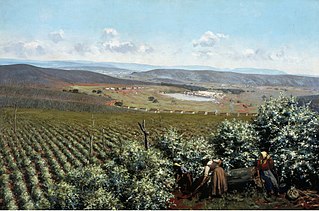
In Brazil's economic history, the coffee cycle was a period in which coffee was the main export product of the Brazilian economy. It began in the mid-19th century and ended in 1930. The coffee cycle succeeded the gold cycle, which had come to an end after the exhaustion of the mines a few decades earlier, and put an end to the economic crisis generated by this decadence.

The second presidency of Getúlio Vargas corresponds to the period of Brazilian political history that began on January 31, 1951, after he won the 1950 presidential election by direct vote with 3,849,040 against 2,342,384 for Eduardo Gomes, becoming the 17th President of Brazil; and ended on August 24, 1954, with his suicide and the vice-president, Café Filho, taking office.

Internal migration in Brazil occurs mainly for economic reasons and ecological disasters. Internal migration involves the movement of people within the same territory, which can be between regions, states or municipalities. It does not affect the total number of inhabitants in a country, but it does change the regions involved in this process. In Brazil, economic factors exert the greatest influence on migratory flows, as the capitalist production model creates privileged areas for industries, forcing people to move from one place to another in search of better living conditions and jobs to meet their basic survival needs.



